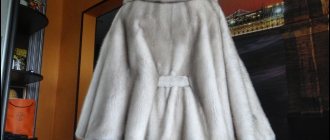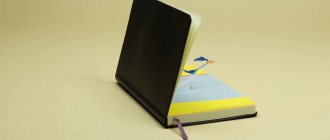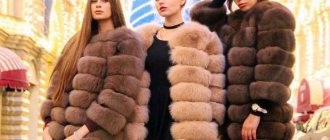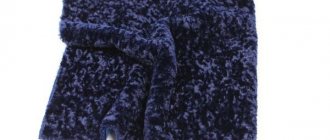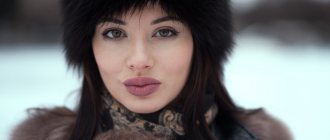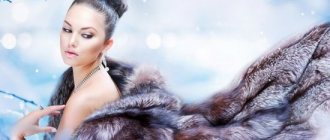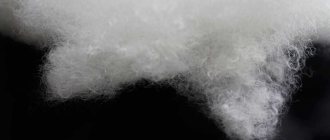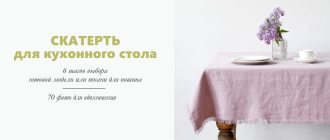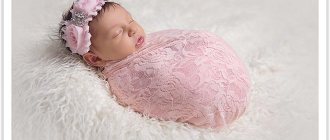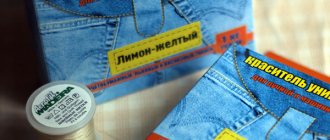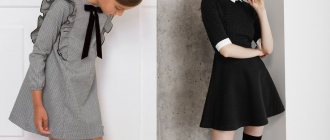Some types of cheap fur are sometimes subjected to such processing as dyeing, tinting, cutting, trimming, after which the fur becomes similar to more expensive fur, imitating its appearance. For example, the fur of a rabbit, marmot or honor is sometimes passed off as natural mink.
In this article we will tell you how to distinguish natural mink fur from imitation and make sure of its quality.
Advantages of a mink coat
Today you can see a large selection of fur coats on sale. There are both more expensive items, for example, fur coats made from vicuna, sable and lynx, and economy class options, among which customers most often choose the fur of arctic fox, fox, beaver, rabbit and ermine. Such products cannot boast of durability and quickly lose their presentation, but they are the most affordable.
The mink coat is especially popular. Mink fur is a very beautiful and soft material; it is positioned as the most successful choice in favor of the price-quality ratio. This fur has a silky and thick coat with the presence of both downy and long guard hairs.
A mink coat is perhaps the best option for those ladies who want to emphasize their status and at the same time manage their finances. Mink coats are valued for their lightness, durability, practicality and preservation of a presentable appearance for several seasons.
Recently, mink fur is often processed using the most advanced technologies - dyeing, shearing, plucking, bleaching and laser processing. Unfortunately, this is taken advantage of by unscrupulous furriers who want to make a profit by passing off cheap fur as mink. When choosing a mink coat, it is sometimes difficult for buyers to understand whether the fur they are being offered is real. In order not to stumble upon a fake, you should know how to identify a mink coat.
Basic rules for purchasing high quality fur products
When planning to purchase a fur coat made of natural fur, you should go to a store that has proven itself well and provides the appropriate certificates and guarantees. In pursuit of savings, you should not look for options in the market. You can find fakes there most often, but then it will be difficult to find the ends.
Now we’ll tell you how to distinguish a high-quality mink coat.
- Mink fur is elastic. Run your hand along the pile in the opposite direction. It should return to its original position. Despite its elasticity and rigidity, the fur does not prick.
- Smooth undercoat, awns of the same length. To disguise a fake, sellers often cut the guard hair so that the length is the same. But in this case, the fur will prick.
- There should be no hair left on the hand when pinched.
- Mink skin has a shine. Single white hairs are sometimes visible on undyed pile.
- Run a white cloth over the fur. There should be no traces of paint left on it.
- The height of the pile on the entire product should be the same. There should be no bald spots, bald spots, or bumps.
- Good manufacturers do not hem the lining, giving the opportunity to inspect the quality of the flesh. It should be light or creamy, elastic.
- When shaking, the fur coat should not rattle.
- Check for stamps on each skin. She confirms that this is mink and indicates the size of the piece (at least 15*15 cm).
- Look carefully at the seams. They should be thin, rolled out and even. Skin is sometimes sewn between fragments of skins. The fewer such areas, the more expensive the product. If you notice the glue, it is better to refuse the purchase. The technology in which the skins are glued together rather than stitched will not allow the product to last for a long time.
How to choose the right fur coat according to your figure
Demanding fashionistas will not be content with just high-quality fur. They want a fur coat to decorate their figure. And on this score, professionals give the following tips:
- A coat of long fluffy fur adds volume.
- If you want to visually slim down, choose a product made from short-cropped smooth fur.
- A fur coat with horizontal stripes can add extra centimeters to you.
- For a basic winter wardrobe, choose a straight fur coat below the hip or to the knee - this silhouette will suit any figure.
- A fur coat in the “cocoon” style is in trend. But the flared “trapezoid” looks a little old-fashioned.
By lenght
When choosing the length of a fur coat, you should definitely take into account two factors: how this fur coat will be worn (public transport, car, going to special events) and the girl’s figure:
- Long, floor-length fur coats amaze with their luxury. But they are completely unsuited to the city crowd and travel on the subway and bus. They look great on tall and slender women; for shorter girls, it makes sense to accentuate the waist with a belt and wear high-heeled boots.
- Medium length (mid-thigh) is the most comfortable and versatile. Classic boots and an elegant bag will help create an elegant and complete look.
- Short fur coats look great on miniature Thumbelina, and are not contraindicated for slender girls of model height. If weather conditions permit, they are very comfortable to wear.
- And finally, the famous “car lady” style is a very short sheepskin coat, often with ¾ sleeves, which is comfortable while driving a car.
—>
How to distinguish the original
When visiting one store after another in search of your ideal mink coat, it is worth checking the products for originality. This is to ensure that you don't end up buying a fake. Remember that even fake mink fur coats can cost no less than the original. Therefore, it is worth resorting to text checks.
Having determined the most successful option for yourself, the first thing you need to do is check for labels on the product. They are the first sign that the fur coat has its own marking, which means it is a factory-quality product. In the case of mink coats, the labels must contain one of the inscriptions - “mink” or “vison(e)”. If there is another inscription, for example, “weasel” or “kolynsky,” then you are not being offered mink, but a product made from cheaper fur, such as rabbit, muskrat or Mongolian marmot.
To check the fur coat for originality, pay attention to the lining. On a real mink product, it will never be completely sewn to the fur; there must be a small gap between the lining material and the skin. This is done so that buyers can check the quality of the back of the skin and the fur itself.
To determine whether you have a real mink coat in your hands, just look into that very gap and carefully examine the product in this place. If you are offered a truly real mink coat, then it will be sewn from trapezoidal pieces of skin, which usually measure 60 by 10-15 cm. If they slip you a product made from the fur of another animal, passing it off as mink, then the skin will have a different shape and sizes.
For example, if a fur coat was made from nutria fur, then the skin will be in the shape of a square, if it is made from muskrat fur, it will be in the shape of a hexagon. Very often, a fur coat is made from rabbit fur to look like a mink; in this case, many have difficulty choosing, since the skin of this animal is very similar to the skin of a mink. But even here it is possible to identify a fake; such a fur coat will be sewn from pieces of material that have the same shape as a mink, only they will be much larger in size.
Experts also recommend carefully examining the flesh. This is tanned leather, where fur grows. As a rule, mink's flesh is softer, more delicate and pleasant to the touch. In color it should be either white or cream, but in no case yellow or dark brown. Even if the flesh is white, this is not always a sign of the original. The fact is that modern technologies make it easy to bleach the flesh. To check whether the skin is dyed or not, pay attention to the beginnings of hair growth; if there are traces of dye on the hairs, then the item is fake.
How to distinguish natural fur from artificial fur: what is the difficulty?
Thanks to modern technologies, manufacturers are able to imitate natural fur so well that many buyers don’t even know about it. For example, today you can see artificial products that are made under:
- raccoon;
- doodle;
- silver fox;
- arctic fox;
- hare;
- mink;
- ermine, etc.
When deciding to make such a purchase, you need to pay attention to many factors that can give off faux fur.
First of all, you need to know how products are made from real and synthetic materials. Natural fur is the tanned skin of an animal along with wool. Synthetic consists of a base and artificial or natural bristles.
In most cases, such fur is made by knitting knitted fabric and adding tufts of wool from combed tape to it. To maintain the strength of the hairs, the fabric is glued to a thin film that is easy to feel. Today, many manufacturers use animal wool and artificial base. The density of the pile in this case is very high, which indicates unnaturalness. The processed flesh does not have such density, because before cutting it is greatly stretched in order to save money.
This is interesting: faux fur first appeared in 1929, but it was made using natural wool - alpaca. It was only in the 50s of the 20th century that this material was created completely synthetic.
Another difficulty when choosing is that dishonest traders can sell products made from real, but cheap material. A chinchilla rabbit is often mistaken for a nutria, because they are very similar. Therefore, you should always buy fur products only in branded stores or salons that have been operating for more than one year. Also, at the time of purchase, the seller must provide a warranty card for a period of one calendar year. During this time, the buyer can exchange the product or get their money back.
What is the difference between tailoring fur coats from Chinese and Scandinavian mink?
High-quality Scandinavian fur coats have fairly high-quality tailoring. Accordingly, all pieces of skin are carefully connected to each other. Sew-in of small leather areas is allowed. The fewer such areas, the better the quality of the fur coat. In addition, coloring is not permitted. The same cannot be said about Chinese models.
Sewing and patterns:
- The fact is that the Chinese are trying to pass off one type of mink as another, and accordingly they can cut it and also dye it. This is quite easy to notice if you look at the reverse side of the fur coat. If the fur is not dyed, then the mink is brown, black or mahogany. At the same time, the reverse side is much lighter than the color of the fur itself. Chinese fur coats are often dyed black.
- Thus, the skin itself, that is, the flesh, is painted dark gray or black. This is not the case in Scandinavian fur coats, and a high-quality black mink coat has a light brown tint on the reverse side. Just like any light fur coat. This is due to the fact that Scandinavian minks are not dyed, but are sold as they are in color.
- Recently, quite often, Greek companies, in order to save money, order fur coats made from European skins in China. Then it is necessary to consider not the skin itself, but the method of joining, as well as the model and tailoring of the fur coat. Very often in China they mess around and start sewing this kind of clothes rather poorly. To be more precise, the distance for connecting the mink pieces is not maintained.
- Thus the seam can be thicker or thinner. This does not happen with Scandinavian fur coats, since almost all the skins are sewn with the same stitch and are of the same thickness. And also Chinese fur coats do not have a huge range of models, that is, patterns. They usually have the same model range, which is the most popular. As for Scandinavian models, here you can choose a fur coat to suit every taste and figure.
Fur coat from China
Signs of a high-quality tanned skin
In order to check the quality of a fur coat as thoroughly as possible, you need to know the stages of processing the skin. Its finishing will be ideal only if the work takes place in a production workshop.
Industrially tanned skins undergo numerous technological processes:
- Dried specimens are soaked in a special solution, and after some time they begin to clean the core. How well this process went can be shown by the smell emanating from the fur coat. If the skins are not properly cleaned of fat and muscle fibers, the skins become rotten and smell bad.
- Degreasing is the next step, designed to remove fatty fibers from the flesh. If this is not done, the skin will rattle when shaken.
- The tanning process gives the product strength. When properly tanned, the skin becomes elastic. After this, it will be able to easily restore its shape with any mechanical action.
- When the tannins penetrate into the layers of the dermis, the skin is dried and treated with a fat emulsion, which will allow the dermis to retain the remaining moisture inside the cells.
- After this, the skins are dried, kneaded well using special rollers and separated into varieties. Low-grade skins are dyed.
Technological process of fur processing
When examining a fur coat, the dyed skin can always be distinguished from the original color. The flesh of a fur coat sewn from high quality natural pieces should be white or slightly yellowish. The yellower the skin color, the older the fur, and the less the coat will be worn. Dyed skins are revealed by the color of the skin. It has the same shade as the fur. Finished skins may have defects:
- hair loss;
- scabs;
- yellow hair;
- exposure and destruction of hair roots;
- keratinization of skin tissue;
- rotting due to violation of processing technology.
Poor quality fur may fall out.
All the shortcomings of poor workmanship will appear during use of the finished product. The smell of raw leather indicates the beginning of decomposition of the flesh. This occurs due to a violation of processing technology, which leads to rapid cell destruction. For this reason, the layers of the skin become very thin and lose their elasticity.
Choosing high-quality mink fur
How to identify a mink coat
Having determined for yourself that you have chosen a fur coat made from real mink, you should not rush to buy it right away. Even if all tests have confirmed the originality of the fur, this does not mean that the product is of high quality. It’s good if this is visible to the naked eye when the fur coat has an unkempt appearance, the fur is uneven, the skins are poorly stitched, and in general if you feel discomfort when trying it on. However, most often the poor quality of the product is not visible at first glance.
There are many ways to help you choose a good fur coat that you won’t mind paying a lot of money for. Below we have tried to present the most important points that are worth paying special attention to:
First of all, you should always check the fur - it should be soft, thick and dense, shine in the sun and shimmer, have not only a thick undercoat, but also guard hair, which is the longest.
Run your wet hand over the product against the direction of the hairs; in the case of high-quality mink fur, the hairs will not remain in your palm.
You can check the quality of the fur by folding or wrinkling any part of the product. Thick and dense hair will never break, and if the fur coat is of poor quality, then you will immediately notice how small hairs have fallen onto the floor.
Try to smell the fur coat; if you smell an unpleasant musty odor or a hint of chemicals, you should not make such a purchase. A high-quality fur coat usually has its own aroma; there may be a faint smell with the scent of a tanned skin.
For a quality fur coat, the lining should not be sewn completely to the fur. This is necessary so that the buyer can check the quality of the meat. It should have the same thickness in different places, have a slight roughness, and be white.
Take the product in your hands and remember it; if the skin begins to crunch, this indicates that the flesh was clearly overdried. Such a fur coat will not last you long, so it is better to immediately refuse to buy it.
The seams can also tell about the quality of a mink coat. Carefully inspect the places where the pieces of fur are sewn together; if there is a distance between them of more than 5 cm, then the fur coat is not of high quality, and it is likely that after a couple of seasons it will begin to tear and come apart at the seams.
The lining of a good mink coat should ideally be made of silk, but even if it is made of cheaper fabric, the quality can be indicated by perfectly even stitching and the presence of a decorative cord sewn along the edges.
There is a simple way to check the quality of the product - stick a regular needle into the skin under the collar,
while moving it in different directions. If the product is of high quality, then the needle will sit tightly in place; if there is a gap at the puncture site, then the fur coat is fake.
If you decide to purchase a dyed mink coat, you need to check the fur for quality of processing. Take any white scarf and squeeze a small bunch of wool in it. If the fabric remains clean, then the fur is well dyed using high-quality dyes, but if not, you have a bad option.
Manufacturer country
Depending on the country in which they are produced, mink coats have several types. Canadian and Scandinavian minks are considered one of the most expensive. They are distinguished by abundant fluff and very thick pile of medium length. The Ukrainian mink is slightly inferior to them. Its underfur is not so thick, and its awn is longer.
Greek fur coats are very popular among Russian women. There is also an opinion that the cost of fur coats is lower in Greece. Some even go on special tours to buy furs. But in any country there are both high-level and less conscientious manufacturers. A high-quality mink fur product will not be cheap. Therefore, it is better not to take risks by making expensive purchases in resort areas.
Russian and Chinese mink coats are much cheaper. Currently, some Chinese manufacturers have also learned to make good quality fur products. But there are also plenty of fakes among them. Therefore, it would be a shame to buy a Chinese fur coat at the price of a Canadian or Greek one. Here are a few signs by which you can distinguish a Chinese fur coat from a European one:
- Ost. Pronounced and very high. Outwardly it seems prickly. It's like she's lying on the pillow. But sometimes the spine does not differ in height. In this case, the skin can be passed off as Scandinavian.
- Shine. Chinese skins do not have a smooth sheen; they seem to shine in areas. They can be recognized by their characteristic glassy sheen. If you compare Chinese and Scandinavian fur coats, even a non-specialist will immediately notice the difference. Scandinavian furs are distinguished by a beautiful diamond shine that seems to shimmer in the sun.
- Undercoat. Depends on the length of the spine. With a long guard, the undercoat is not dense. Sometimes a mink with short hair and long black fur is passed off as a black mink. But natural black mink has a light core, which after dyeing takes on a dark or gray tint.
Based on these indicators, you can understand where the animal was raised. The place where the fur coat was produced is determined by the sewing technology. In most cases, Greek and Italian fur coats are made from Finnish and Scandinavian skins. Russian mink differs from Chinese mink in having thick and long pile, while Scandinavian mink has thick but short pile.
Sometimes the Chinese use Greek furs for tailoring. In this case, quality should be determined by sewing technology.
Operation and care
Any item reflects the care given to its owner during use. The service life of a mink coat during dissolution will be extended, and its appearance will be preserved if it is treated with care and properly cared for.
If your mink coat has been exposed to precipitation during dissolution, it is best not to try to save it with a hair dryer or other devices, but to let it dry quietly in a cool, dry room. Never straighten dried fur with a comb; shaking the product several times will be enough.
Try not to carry bags or backpacks over your shoulder. Fur creases may form in this area over time (even with high-quality fur coats).
To store mink coats for dismantling during the warm season, some cities have special refrigerated storage facilities where you can return the item for a subscription fee. If such a service does not exist in your city, then for storage it is best to place the fur coat in a breathable dark-colored case and put it in the darkest and coolest place in the apartment. Sprinkling with mothballs or anti-mole preparation is not recommended. Place this medication in your pockets, wrapping it in gauze.
While the winter season has not yet arrived, but the weather is cloudy and humid, it would be a good idea to hang your fur coat on the balcony so that the skin and fur are saturated with moisture and are more elastic.
A mink coat should not be dry-cleaned, but if this is necessary, dry cleaning should be very delicate.
Where is the best place to buy a mink coat?
Before you go looking for a mink coat, you need to think about where exactly you will make the purchase - in a regular store where clothes are sold, in a specialized fur salon or in the market? Of course, there is a great temptation to go to the market, since this is where you can buy a fur coat at an affordable price. However, this option should be immediately discarded, since most often fur coats purchased on the market turn out to be fake.
Therefore, it is worth looking at those options where you can definitely choose a quality product. It is best to go to specialized salons that have proven themselves to be the best and have a large number of positive reviews.
What is the reason for this? Firstly, in such stores you can be provided with a certificate that will confirm the quality of the mink coat, secondly, if you find any defect, you can take the fur product back to the store and get your money back, thirdly, it is simply not profitable for large suppliers lose your status in front of a large number of buyers.
Also, do not be fooled by offers from advertisements. No matter how good a fur coat looks, and no matter how low its cost, there is a big risk of buying a cheap fake. In this way, people who, due to their inexperience and ignorance, have purchased a low-quality product, are trying to sell fur coats. And in order to somehow return part of the lost amount, they are looking for equally inexperienced buyers who would fall for the low price.
Remember that any fur product is an expensive purchase. And such a thing as a mink coat is a real luxury. In order not to overpay for a fake, it is worth applying the above methods of checking quality, as well as making purchases in reputable stores. Then you will buy the fur coat of your dreams, which will reliably serve you for several years and you won’t mind paying a lot of money for.
Seams and fur on the inside
It is important to pay attention to the number of seams. The service life of the product directly depends on this criterion. If small pieces were used to make a fur coat, it is most likely that the product will become unusable very soon.
You should also pay attention to the reverse side of the fur. The inside of the skin should be light in color. The yellowness indicates that old fur was used to make the fur coat. In this case, the fur coat will not last as long as we would like.
